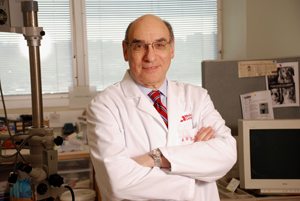 |
Irving Zucker, Ph.D., professor and chairman of the department of cellular and integrative physiology, was named UNMC’s second Scientist Laureate in 2008. |
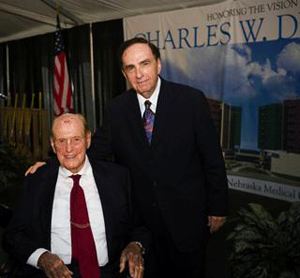 |
Chuck Durham, left, and Chancellor Harold M. Maurer, M.D., at a 2006 ceremony at UNMC. Durham, whose support transformed the UNMC campus, died in April at 90. |
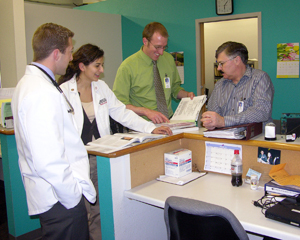 |
Sharing students review the patient schedule with faculty adviser, Jim Medder, M.D., right. The students from left are Keith Jensen, Erica Peterson and Bill Dorwart. All three are second-year medical students. The SHARING Clinics celebrated their 10th anniversary in 2008. |
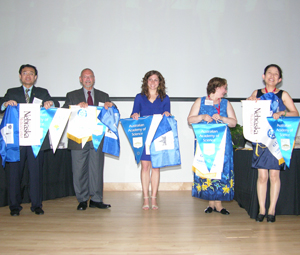 |
Representatives from the participating institutions, including UNMC’s Tom Rosenquist, Ph.D., second from left, exchange school flags during the International Student Research Forum’s closing ceremonies in June. |
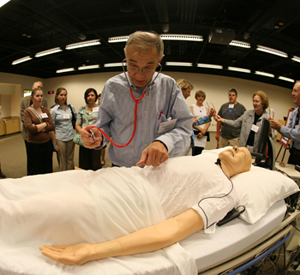 |
Edward “Ted” Holyoke, M.D., a 1970 College of Medicine alumnus, tries out one of the patient simulators in the new Sorrell Center, which opened in June. The state-of-the-art new building is now home to the College of Medicine. |
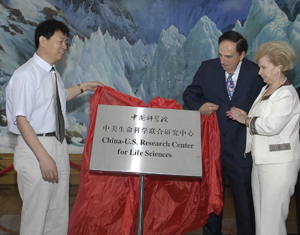 |
From left, Dr. Jiayang Li, vice president of the Chinese Academy of Science, UNMC Chancellor Harold M. Maurer, M.D., and Beverly Maurer unveil a plaque commemorating the formation of the joint research center between UNMC and the Chinese Academy of Science om August. |
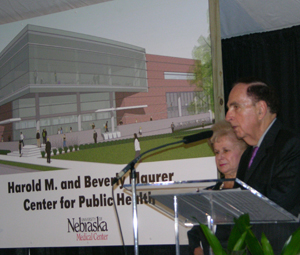 |
UNMC Chancellor Harold M. Maurer, M.D., and his wife, Beverly, make comments in August, moments after it was announced that the new College of Public Health building will be named for the couple. |
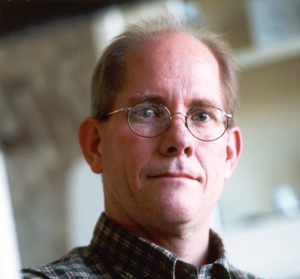 |
Tony Hollingsworth, Ph.D., leads a prostate cancer research group that has secured a $5.3 million SPORE grant from the National Cancer Institute. |
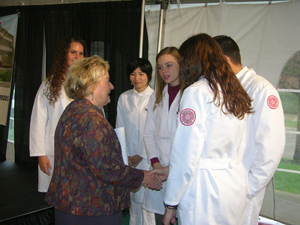 |
Omaha philanthropist Ruth Scott meets with College of Nursing students at a groundbreaking ceremony in October for a new College of Nursing building in on the Omaha campus. Scott, and her husband, Bill, have given several major gifts to UNMC in the past few years that have enabled UNMC to construct several buildings including the new nursing building and the Sorrell Center. |
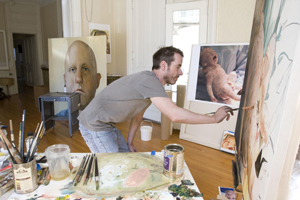 |
UNMC Artist-in-Residence Mark Gilbert works in his medical center studio. Works from his stint at UNMC are now on display at the Bemis Center for Contemporary Arts as part of the “Portraits of Care: Here I Am and Nowhere Else” exhibit. |
As the year began, UNMC welcomed John Sparks, M.D., to campus to take over as chairman of the department of pediatrics for Bruce Buehler, M.D., who stepped down after serving in the position for more than 16 years.
Also in January, Irving Zucker, Ph.D., professor and chairman of the department of cellular and integrative physiology, was named the second UNMC Scientist Laureate.
In February, UNMC learned that initiatives such as surgical robots and a statewide lung cancer screening program would benefit from about $12 million in federal earmarks that Congress had approved.
Later in the month, Omaha philanthropists Ruth and Bill Scott gave a large gift to the University of Nebraska Foundation that would allow for the construction of the College of Public Health building and a second building for the College of Nursing in Omaha and a student plaza.
In March, UNMC and four Japanese Institutions — University of Tsukuba, Tokyo Science University, Osaka University and RIKEN — signed an agreement to form a materials medicine network that pursues research in nanomedicine and other fields.
Also in March, Steven Hinrichs, M.D., was named chairman of the pathology and microbiology department.
April marked the 10th anniversary of the founding of UNMC’s student-run SHARING Clinics, which provide low cost health care to underserved populations.
Later in the month, UNMC learned that it again ranked high in the annual U.S.News and World Report ranking of the best colleges and universities. The medical center’s rural health medicine program ranked 11th nationally and the primary care program ranked 20th.
April also featured the opening of the the $1.2 million Weigel Williamson Center for Visual Rehabilitation on the UNMC campus and the news that the UNMC family medicine department received the University-wide Teaching Award.
In May, the Journal of the American Medical Association’s (JAMA) Archives of Otolarynogology published a study by UNMC’s William Lydiatt, M.D., and Bill Burke, M.D., that showed antidepressants used as part of a treatment regimen help reduce depression risk in head and neck cancer patients.
The media exposure in major science journals continued in May as the New England Journal of Medicine published an HIV study co-authored by UNMC’s Susan Swindells, M.B.B.S., that confirmed that one of the most frequently prescribed triple-drug combinations for initial HIV infection is the most effective for suppressing HIV but that a two-drug regimen does perform comparably to the popular triple-drug regimen.
In early June, UNMC hosted the International Student Research Forum that included students from China, Japan, Australia and Russia.
On the funding front, the pharmacology and experimental neuroscience department announced that it had collectively secured seven National Institutes of Health grants that totaled more than $12 million.
In late June, UNMC Chancellor Harold M. Maurer, M.D., and several other medical center leaders headed to western Nebraska for the chancellor’s annual outstate leadership tour. The trip included stops in Lexington, North Platte, Scottsbluff, Chadron, Alliance, Sidney and Ogallala.
As the month came to a close, UNMC opened the state-of-the-art Michael F. Sorrell Center for Health Science Education — a four-level, $52.7 million facility that was built to house the UNMC College of Medicine.
In July, the National Institutes of Health renewed UNMC’s Peggy Wheelock’s Centers of Biomedical Research Excellence (CoBRE) grant for another five years at $10.9 million.
UNMC learned in July that it had joined the likes of Harvard, Yale and Washington University on the Chinese Scholarship Council’s (CSC) list of preferred U.S. institutions for student exchanges. The CSC is a powerful, Beijing-based group that selects top graduate students from elite Chinese universities to participate in exchange and research programs at select U.S. institutions.
Also in July, Phil Smith, M.D., published a study in JAMA that showed U.S. nursing homes would not be prepared in the event of a pandemic.
In August, Dr. Maurer and his wife, Beverly, went to China and signed agreements that led to the establishment of:
- A joint M.D./Ph.D. program between UNMC and Shanghai Jiao Tong University School of Medicine, the first such partnership between a U.S. and Chinese institution; and
- The Research Center for Life Sciences — a collaboration between UNMC and the Chinese Academy of Sciences.
Later in the month — UNMC announced that it had again acquired a record total for research funding in fiscal year 2007-2008 with $82.2 million during that time.
Dr. and Mrs. Maurer were in the spotlight again in August when ground broke on a building for the College of Public Health and a surprise announcement was made that the building would be named the Harold M. and Beverly Maurer Center for Public Health.
In September, the College of Medicine welcomed 130 new students to campus — marking the first time in about 30 years the college increased its class size — and the School of Allied Health Professions moved into newly renovated Bennett Hall — unifying the school completely under one roof for the first time in its history.
The National Cancer Institute in September awarded a $5.3 million, five-year Specialized Program of Research Excellence (SPORE) grant in pancreatic cancer to the UNMC Eppley Cancer Center. UNMC was one of only two programs funded this year in pancreatic cancer research.
September also saw ground break on the Home Instead Center for Successful Aging. The center, which was made possible thanks to a large gift from Paul and Lori Hogan, founders of Home Instead Senior Care, will offer specialized services aimed at helping seniors age better and live healthier lives. The center will be the only free-standing center focused on aging tied to an academic medical center in Nebraska and the region.
October brought news that UNMC had netted a record $32.2 million in research funding for the first quarter of 2008-2009 — by far the highest total ever obtained by medical center investigators during a single quarter.
UNMC broke out the shovels again in October to break ground on a new building for the College of Nursing in Omaha. The $14 million building will sit directly behind the current nursing building.
Also in October, a UNMC contingent traveled to China to make further inroads with academic health science institutions in that country.
In November, UNMC held its annual United Way campaign and — for the second-straight year — surpassed its goal by collecting more than $140,980.
Another campaign — this time of the video variety — started in November as UNMC launched the “I Love UNMC” campaign, which asked employees, students, alumni and others to submit short videos showing why they love the medical center. While still early in the campaign, already the videos have given employees the opportunity to show their creativity along with their affinity for UNMC. Click here to see more about the “I Love UNMC” campaign.
At its November meeting, the University of Nebraska Board of Regents approved the name Durham Research Center II for the second research tower on the west end of the UNMC campus.
Also in November, the bone marrow and stem cell transplant program at UNMC and The Nebraska Medical Center celebrated its 25-year anniversary.
In December, the UNMC community was highlighted in the art world as the “Portraits of Care: Here I Am and Nowhere Else” exhibit opened at the Bemis Center for Contemporary Arts in Omaha. The exhibit features portraits composed by Scottish artist, Mark Gilbert, during his two-year stint as UNMC’s artist-in-residence.
UNMC said goodbye to some friends and family members in 2008, too, including Omaha philanthropist Charles “Chuck” Durham, who died in April at 90. Durham’s support helped transform the UNMC campus and is noted by the many campus buildings and streets that bear his name.
F. Miles Skultety, M.D., Ph.D., who in the 1970s and 1980s played a key role in UNMC’s transformation into a major academic health sciences center, died in November at 86 after a battle with prostate cancer.
Also in November, Darrel Moreland, D.D.S., a strong supporter of the UNMC College of Dentistry and a friend to many at the University of Nebraska, died following an apparent heart attack.